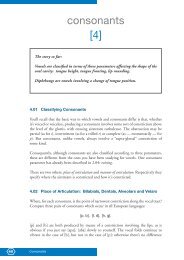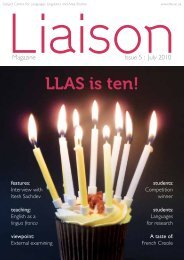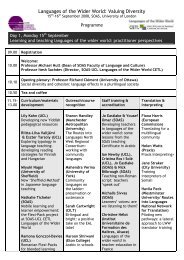PHONETICS MANUAL.indd - HumBox
PHONETICS MANUAL.indd - HumBox
PHONETICS MANUAL.indd - HumBox
Create successful ePaper yourself
Turn your PDF publications into a flip-book with our unique Google optimized e-Paper software.
59. If the IPA symbol [x] represents a velar fricative (unknown in most varieties<br />
of English), how would a word containing x in the spelling be transcribed?<br />
Extra, for instance. (Think carefully about what this letter corresponds to in the<br />
pronunciation.)<br />
60. Non-technical books sometimes try to describe Spanish [¬] by talking about “a<br />
cross between b and v”. What are they getting at?<br />
61. Rewrite in ordinary (English) spelling:<br />
[lA:fs] [kl@UDz] [hi:Dnz] [peISns] [@UT] [w@:Tl@s] [Tˆm]<br />
[f{Sen] [kl@UZe] [lˆS@s] [beIZ] [ju:ZU@l] [S@rA:d] [lˆkS@rI].<br />
62. Transcribe, using IPA symbols:<br />
cake, bouquet, bagpipes, oaths, gnaw, sash, pleasure, Asia, breath,<br />
breathe, photo, physics, warmth, theatre, though.<br />
4.06 More Places: Palatal, Uvular, Pharyngeal, Glottal<br />
So far six places of articulation have been introduced, from bilabial to velar. In actual<br />
fact, a constriction giving rise to a consonant can be made at any point along the<br />
vocal tract by bringing two “articulators” into contact. The tongue in particular<br />
being highly mobile, different parts of it can close against different parts of the<br />
roof of the mouth, giving a range of subtly varied consonants, all of which occur<br />
in some language or another. However, the IPA contents itself with ten places of<br />
articulation, so here is the chart again with the remaining four added (underlined).<br />
Finer intergradations can be indicated if required by use of pre- (“in front of”) or post-<br />
(pre-velar, post-palatal, etc.)<br />
FIG. 33<br />
bilabial<br />
dental<br />
alveolar<br />
palatal velar uvular<br />
labiodental<br />
postalveolar<br />
pharyngeal<br />
glottal<br />
STOP ?<br />
FRICA-<br />
TIVE<br />
C<br />
h<br />
Most of these additional places of articulation are relevant to at least one of the wellknown<br />
European languages, and you should note the existence of the others. So a few<br />
further symbols have been inserted. Here is some information about the sounds that<br />
they represent.<br />
Consonants<br />
49






